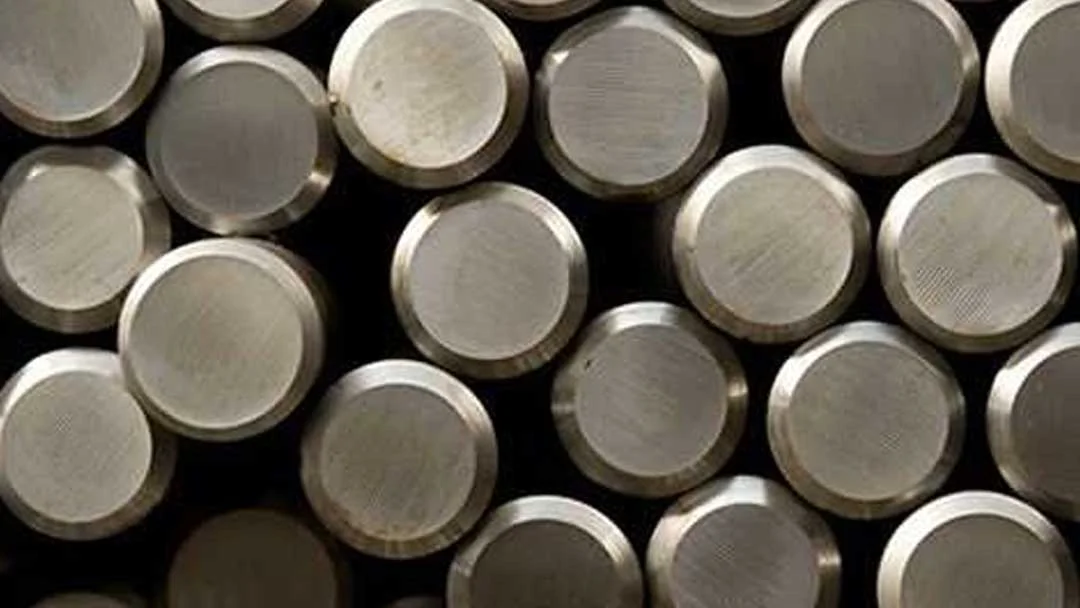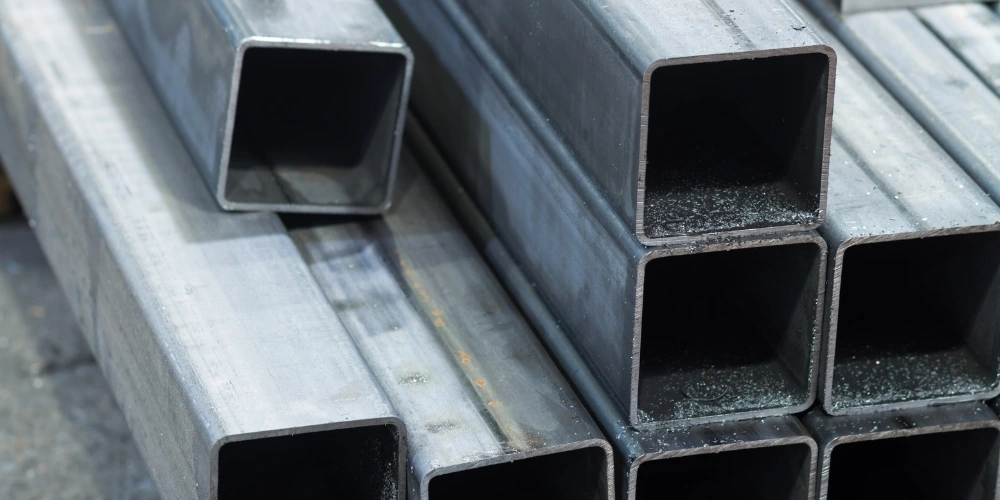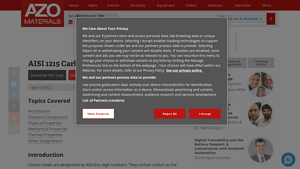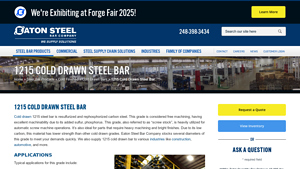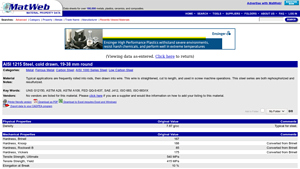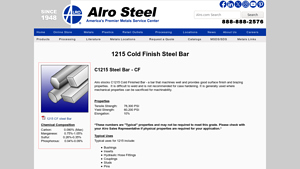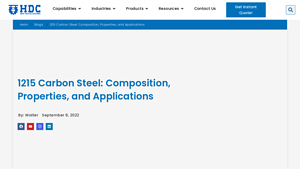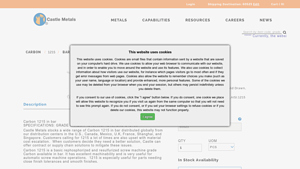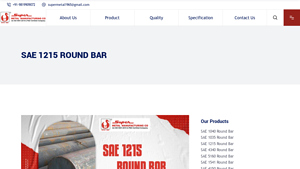1215 Steel Composition Guide: Type, Cost, Top List…
Introduction: Navigating the Global Market for 1215 steel composition
In today’s competitive landscape, sourcing high-quality 1215 steel composition can pose significant challenges for international B2B buyers. This grade of carbon steel, renowned for its exceptional machinability due to its resulfurized and rephosphorized properties, is essential for industries ranging from automotive to construction. However, understanding the nuances of 1215 steel—including its chemical composition, mechanical properties, and ideal applications—is crucial for making informed purchasing decisions that align with operational needs and budget constraints.
This comprehensive guide serves as a vital resource for B2B buyers across Africa, South America, the Middle East, and Europe, including key markets like Vietnam and Nigeria. We will explore various aspects of 1215 steel, including its specific types, applications, and the critical factors to consider when vetting suppliers. Additionally, we will provide insights into cost implications and sourcing strategies that can optimize procurement processes.
By delving into the intricacies of 1215 steel composition, this guide empowers buyers to navigate the global market with confidence. Whether you are looking to enhance your manufacturing capabilities or seeking reliable suppliers, our authoritative insights will equip you with the knowledge needed to make strategic decisions that drive business success.
Understanding 1215 steel composition Types and Variations
| Type Name | Key Distinguishing Features | Primary B2B Applications | Brief Pros & Cons for Buyers |
|---|---|---|---|
| 1215 Cold Drawn Bar | Resulfurized and rephosphorized, excellent machinability, low carbon content | Automotive parts, construction fittings | Pros: High machinability, good surface finish. Cons: Lower strength compared to higher carbon steels. |
| 1215 Bright Bar | Polished surface, enhanced aesthetic appeal, tight tolerances | Precision machinery, decorative applications | Pros: Superior finish and tolerance. Cons: Higher cost due to processing. |
| 1215 Hex Bar | Hexagonal shape, suitable for specific applications, good strength | Fasteners, specialized fittings | Pros: Versatile shape for various applications. Cons: Limited availability in certain markets. |
| 1215 Square Bar | Square cross-section, easy to handle and machine, stable structure | Structural components, automotive parts | Pros: Easy to fabricate and weld. Cons: May require additional processing for certain uses. |
| 1215 Flat Bar | Flat profile, customizable sizes, good for welding and fabrication | Construction beams, brackets, and supports | Pros: Flexible applications and easy to process. Cons: Less suitable for high-stress applications. |
What are the Key Characteristics of 1215 Cold Drawn Bar?
The 1215 Cold Drawn Bar is recognized for its resulfurized and rephosphorized composition, which significantly enhances its machinability. This grade is ideal for automatic screw machine operations and applications that require extensive machining. When purchasing, consider the specific diameter and length requirements, as this grade is available in various sizes. Buyers should note that while it offers excellent machining properties, its lower carbon content results in reduced strength compared to higher-grade steels.
Why Choose 1215 Bright Bar for Precision Applications?
1215 Bright Bar features a polished surface that not only improves its aesthetic appeal but also enhances its dimensional accuracy and surface finish. This type is especially suitable for precision machinery and decorative applications where appearance matters. Buyers should evaluate the cost versus the benefits of improved finish and tolerance, as the processing involved in producing bright bars can lead to a higher price point.
How Does 1215 Hex Bar Stand Out in the Market?
The 1215 Hex Bar is characterized by its unique hexagonal shape, making it suitable for specific applications like fasteners and specialized fittings. This shape allows for better grip and torque application in various mechanical environments. When sourcing, buyers should ensure that the hex bar’s dimensions meet their application needs, as availability may vary by region. The versatility of this bar type makes it a popular choice, but its market availability can sometimes be limited.
What Makes 1215 Square Bar a Reliable Choice?
The 1215 Square Bar offers a stable structure with a square cross-section, making it easy to handle and machine. It is commonly used in automotive parts and structural components due to its favorable welding characteristics. Buyers should consider the specific dimensions required for their projects, as square bars can be more readily available in certain sizes. While it is easy to fabricate, additional processing may be necessary for high-stress applications.
Why is 1215 Flat Bar Ideal for Construction?
The 1215 Flat Bar is a versatile option for construction applications, known for its customizable sizes and ease of fabrication. It is widely used for beams, brackets, and supports, making it a staple in construction projects. When purchasing flat bars, buyers should focus on thickness and width specifications to ensure they meet project requirements. While it provides flexibility in applications, it may not be the best choice for high-stress uses due to its lower strength profile.
Key Industrial Applications of 1215 steel composition
| Industry/Sector | Specific Application of 1215 steel composition | Value/Benefit for the Business | Key Sourcing Considerations for this Application |
|---|---|---|---|
| Automotive | Precision machined components | Enhanced machinability leading to cost-effective production | Consistent quality, availability in various diameters, and compliance with industry standards |
| Construction | Fasteners and structural fittings | High durability and reliability under stress | Sourcing from reputable suppliers to ensure material integrity and certifications |
| Manufacturing | Automatic screw machine operations | Increased efficiency in high-volume production | Availability of cold drawn bars in various shapes and sizes to meet specific design requirements |
| Aerospace | Engine components and structural parts | Lightweight yet strong materials for improved performance | Adherence to strict aerospace material standards and traceability in sourcing |
| Electrical Engineering | Connectors and bushings | Excellent electrical conductivity and machinability | Need for precise specifications and reliable delivery timelines to meet project schedules |
In the automotive industry, 1215 steel composition is widely used for precision machined components such as gears and shafts. Its excellent machinability allows manufacturers to produce intricate parts efficiently, reducing production costs. International buyers must ensure they source from suppliers who can provide consistent quality and meet specific industry standards to avoid delays in production.
Within the construction sector, 1215 steel is utilized for fasteners and structural fittings due to its high strength and durability. These applications require materials that can withstand significant stress, ensuring safety and longevity in construction projects. Buyers should prioritize sourcing from reputable suppliers who can guarantee material integrity and compliance with local building codes.
In manufacturing, 1215 steel is favored for automatic screw machine operations, where high-volume production of components is essential. The steel’s properties facilitate rapid machining, resulting in significant time savings and increased operational efficiency. Buyers should consider suppliers that offer a variety of shapes and sizes to accommodate diverse design requirements.
In the aerospace sector, 1215 steel is employed in the production of engine components and structural parts. The lightweight yet strong characteristics of this steel make it ideal for enhancing the performance of aircraft. Buyers in this field must ensure that their sourcing adheres to stringent aerospace material standards and traceability requirements to maintain safety and compliance.
Finally, in electrical engineering, 1215 steel is used for connectors and bushings, where excellent electrical conductivity is crucial. Its machinability also allows for the production of complex designs. Buyers should focus on precise specifications and reliable delivery timelines to align with project schedules and ensure seamless integration into electrical systems.
3 Common User Pain Points for ‘1215 steel composition’ & Their Solutions
Scenario 1: Difficulty in Achieving Desired Machinability
The Problem: B2B buyers often face challenges with the machinability of 1215 steel, especially when the end-use application requires precise dimensions and finishes. This can lead to increased production times and costs, particularly in industries such as automotive or manufacturing where components like pins, couplings, and fittings are critical. If the steel does not machine well, it can result in tool wear, production delays, and ultimately, unsatisfied customers.
The Solution: To enhance machinability, buyers should ensure they are sourcing high-quality 1215 steel that meets ASTM A108 or ASTM A576 specifications. When placing orders, it is crucial to communicate specific requirements for surface finish and tolerances, as these can significantly impact machining efficiency. Additionally, utilizing advanced machining techniques, such as optimizing cutting speeds and feeds, can improve performance. Engaging with suppliers who provide detailed technical data sheets can also help in selecting the right type of 1215 steel that aligns with the machining capabilities of the equipment being used.
Scenario 2: Inconsistent Quality and Composition Variability
The Problem: Buyers may encounter variability in the chemical composition of 1215 steel from different suppliers, which can affect the mechanical properties of the final products. Variability in sulfur and phosphorus content, for instance, can lead to inconsistencies in strength and ductility. This inconsistency can be particularly detrimental for businesses operating in critical sectors like construction or aerospace, where component reliability is paramount.
The Solution: To mitigate the risks associated with composition variability, it is essential for buyers to establish long-term relationships with reputable suppliers who have a track record of quality assurance. Requesting certificates of compliance and batch test results can provide assurance regarding the chemical composition of the steel. Buyers should also consider conducting their own testing on samples before committing to large orders. Implementing a robust quality control process within the supply chain can help ensure that the materials received consistently meet the required specifications.
Scenario 3: Limited Availability and Supply Chain Disruptions
The Problem: International buyers, especially those in regions like Africa or South America, may experience challenges in sourcing 1215 steel due to limited availability or supply chain disruptions. This can lead to delays in production schedules, impacting project timelines and customer commitments. The unpredictability of supply can be particularly problematic in industries that rely on just-in-time manufacturing practices.
The Solution: To address these supply chain challenges, buyers should diversify their sourcing strategies by establishing relationships with multiple suppliers across different regions. This not only mitigates the risk of shortages but also allows for competitive pricing. Additionally, leveraging technology such as supply chain management software can provide visibility into inventory levels and order statuses, enabling proactive decision-making. Building contingency plans, such as maintaining a buffer stock of critical materials, can also help in managing unexpected disruptions effectively.
Strategic Material Selection Guide for 1215 steel composition
What Are the Key Properties of 1215 Steel Composition?
1215 steel, categorized as a resulfurized and rephosphorized carbon steel, boasts excellent machinability, making it a preferred choice for automatic screw machine operations. Its chemical composition typically includes a maximum carbon content of 0.09%, manganese ranging from 0.75% to 1.05%, phosphorus at 0.04% to 0.09%, and sulfur between 0.26% and 0.35%. These properties contribute to its suitability for applications requiring complex machining and bright finishes, such as pins, couplings, and bushings.
What Are the Pros and Cons of Using 1215 Steel?
The primary advantage of 1215 steel lies in its exceptional machinability, which allows for faster production rates and reduced tool wear during machining processes. This can lead to lower manufacturing costs and shorter lead times, making it an attractive option for B2B buyers focused on efficiency. However, its lower carbon content results in reduced strength compared to other cold drawn grades, which may limit its use in high-stress applications. Additionally, while it is relatively cost-effective, the need for specialized machining may increase overall production complexity.
How Does 1215 Steel Impact Application Performance?
1215 steel’s unique composition makes it compatible with various media, particularly in environments where high machinability is essential. Its applications span industries such as automotive and construction, where components like fittings and studs are commonly used. However, it is crucial for international buyers to assess environmental factors, such as humidity and temperature variations, which could affect the performance of 1215 steel in specific applications.
What Should International B2B Buyers Consider When Sourcing 1215 Steel?
For B2B buyers in regions like Africa, South America, the Middle East, and Europe, compliance with international standards such as ASTM A108 and ASTM A576 is vital. Buyers should also consider local regulations and certifications that may affect material sourcing. Understanding the common preferences in these regions, such as the need for specific shapes and sizes, can further streamline procurement. Additionally, buyers should evaluate suppliers based on their ability to meet minimum order quantities and delivery timelines, which can vary significantly across different markets.
Summary Table of 1215 Steel Composition Materials
| Material | Typical Use Case for 1215 steel composition | Key Advantage | Key Disadvantage/Limitation | Relative Cost (Low/Med/High) |
|---|---|---|---|---|
| 1215 Steel | Automatic screw machine parts | Excellent machinability | Lower strength compared to other grades | Medium |
| Cold Drawn Bar | Precision components like pins and bushings | Smooth finish and tight tolerances | Requires specialized machining | Medium |
| Resulfurized Steel | Fittings and couplings | High production efficiency | Limited high-stress applications | Medium |
| Phosphorized Steel | Automotive parts and construction elements | Enhanced surface quality | May not be suitable for corrosive environments | Medium |
This strategic material selection guide provides a comprehensive overview of 1215 steel composition, emphasizing its properties, advantages, and considerations for international B2B buyers. Understanding these factors can significantly enhance decision-making and procurement strategies in diverse markets.
In-depth Look: Manufacturing Processes and Quality Assurance for 1215 steel composition
What Are the Main Stages of Manufacturing 1215 Steel Composition?
The manufacturing process of 1215 steel involves several critical stages, each essential for ensuring the final product meets the required specifications and quality standards. These stages typically include material preparation, forming, assembly, and finishing.
-
Material Preparation
The initial step involves sourcing raw materials, primarily resulfurized and rephosphorized carbon steel. The steel is melted in an electric arc furnace, where careful control of chemical composition is vital. The specific percentages of carbon, manganese, phosphorus, and sulfur must be maintained to ensure optimal machinability and performance characteristics. -
Forming
After preparation, the steel undergoes forming processes such as hot rolling and cold drawing. Hot rolling involves heating the steel above its recrystallization temperature, which allows for easier shaping into desired forms. Following this, cold drawing is employed to achieve tighter tolerances and improved surface finish. The cold drawn bars are particularly valued for their enhanced machinability and are often produced in various shapes, including round, hexagonal, and square. -
Assembly
While 1215 steel is not typically assembled in the conventional sense, it is crucial for manufacturers to ensure that the produced bars and sections meet the dimensional specifications required for end-use applications. This includes verifying that the steel can be easily machined into components like pins, bushings, and fittings, which are commonly used in industries such as automotive and construction. -
Finishing
The finishing stage includes processes such as surface treatment and polishing. This step is essential for improving the aesthetic quality and corrosion resistance of the steel. Techniques such as sandblasting, pickling, or applying protective coatings may be utilized to enhance the final product’s durability and appearance.
How Do Quality Assurance Practices Ensure the Integrity of 1215 Steel?
Quality assurance (QA) is a critical aspect of manufacturing 1215 steel, ensuring that products meet international standards and customer specifications. The QA process is structured around various international and industry-specific standards, which guide manufacturers in maintaining high-quality production.
-
Relevant International Standards
Adherence to international standards like ISO 9001 is essential for manufacturers aiming to establish a quality management system. This standard ensures that organizations consistently meet customer and regulatory requirements, thereby enhancing customer satisfaction. Additionally, for specific markets, certifications such as CE marking or API (American Petroleum Institute) standards may be required, especially in industries like oil and gas. -
Quality Control Checkpoints
Quality control (QC) checkpoints are integrated throughout the manufacturing process to identify and rectify defects early. These checkpoints include:
– Incoming Quality Control (IQC): This involves inspecting raw materials upon arrival to ensure they meet specified requirements.
– In-Process Quality Control (IPQC): During manufacturing, regular inspections are conducted to monitor processes and detect any deviations from the established standards.
– Final Quality Control (FQC): Once manufacturing is complete, a thorough inspection of the final product is performed to ensure compliance with specifications before shipment.
What Testing Methods Are Commonly Used in the Quality Assurance of 1215 Steel?
Various testing methods are employed to assess the mechanical and chemical properties of 1215 steel, ensuring it meets the required standards for its intended applications.
-
Mechanical Testing
Common mechanical tests include tensile strength tests, yield strength tests, and hardness tests (such as Brinell or Rockwell hardness). These tests help determine the material’s ability to withstand stress and deformation, which is crucial for components subjected to dynamic loads. -
Chemical Composition Analysis
Spectroscopic analysis methods, such as Optical Emission Spectroscopy (OES), are used to verify the chemical composition of the steel. Ensuring that the levels of carbon, sulfur, phosphorus, and manganese are within specified limits is vital for achieving the desired machinability and performance characteristics. -
Non-Destructive Testing (NDT)
NDT methods, such as ultrasonic testing or magnetic particle inspection, may also be employed to detect internal defects without damaging the material. These methods are particularly beneficial for ensuring the integrity of critical components used in high-stress applications.
How Can B2B Buyers Verify Supplier Quality Control?
B2B buyers must take proactive steps to verify the quality control measures of their suppliers, especially when sourcing from international markets. Here are several strategies to consider:
-
Conducting Supplier Audits
Before committing to a supplier, conducting a thorough audit of their manufacturing processes and quality control systems is advisable. This includes reviewing their certifications, quality management systems, and historical performance data. -
Requesting Quality Control Reports
Suppliers should provide detailed QC reports that outline the results of various testing methods and inspections conducted throughout the manufacturing process. These reports should include information on compliance with international standards and any corrective actions taken for non-conformities. -
Utilizing Third-Party Inspections
Engaging third-party inspection services can provide an unbiased assessment of the supplier’s quality control practices. These organizations can conduct on-site inspections and testing, offering an additional layer of assurance regarding product quality. -
Understanding Certification Nuances
For international buyers, it’s essential to understand the nuances of different certifications and quality standards. Familiarity with the specific requirements for markets in Africa, South America, the Middle East, and Europe can help ensure compliance and avoid potential pitfalls in procurement.
Conclusion
The manufacturing processes and quality assurance practices for 1215 steel composition are critical for ensuring that the material meets the stringent demands of various industries. By understanding these processes and implementing rigorous quality control measures, B2B buyers can confidently source high-quality materials that align with their operational needs and industry standards.
Practical Sourcing Guide: A Step-by-Step Checklist for ‘1215 steel composition’
Introduction
Sourcing 1215 steel composition requires a strategic approach to ensure you acquire the right material for your manufacturing needs. This guide will provide actionable steps for B2B buyers, particularly those operating in diverse markets such as Africa, South America, the Middle East, and Europe. By following this checklist, you can make informed decisions that align with your technical specifications and business goals.
Step 1: Define Your Technical Specifications
Establishing clear technical specifications for 1215 steel is crucial for successful procurement. Identify the required chemical composition, mechanical properties, and any specific dimensions or shapes needed for your project. This clarity will help ensure that suppliers can meet your exact needs and reduce the risk of receiving subpar materials.
- Chemical Composition: Ensure the steel meets standards like ASTM A108 or ASTM A576, focusing on key elements such as Carbon (max 0.09%), Manganese (0.75-1.05%), Phosphorus (0.04-0.09%), and Sulfur (0.26-0.35%).
- Mechanical Properties: Look for tensile strength, yield strength, and elongation percentages that align with your application requirements.
Step 2: Research and Identify Potential Suppliers
Conduct thorough research to identify suppliers with a solid reputation in the market. Utilize online resources, industry directories, and trade shows to compile a list of potential vendors specializing in 1215 steel.
- Supplier Experience: Look for suppliers with extensive experience in providing 1215 steel, particularly those who serve industries relevant to your operations, such as automotive or construction.
- Geographical Considerations: Consider suppliers located within or near your target market to minimize shipping costs and lead times.
Step 3: Evaluate Potential Suppliers
Before committing, it’s crucial to vet suppliers thoroughly. Request company profiles, case studies, and references from buyers in a similar industry or region. This evaluation helps ensure reliability and quality.
- Certifications: Verify that suppliers hold relevant industry certifications, such as ISO 9001, which demonstrate their commitment to quality management.
- Client Testimonials: Seek feedback from previous customers to gauge satisfaction levels and any potential issues.
Step 4: Request Detailed Quotations
Once you’ve narrowed down your list of suppliers, request detailed quotations. A well-structured quote should outline pricing, delivery timelines, and payment terms.
- Price Breakdown: Ensure the quote provides a breakdown of costs, including unit prices, shipping, and any additional fees.
- Lead Times: Confirm estimated lead times for delivery, especially if you have tight project timelines.
Step 5: Conduct Material Testing (If Necessary)
Depending on the application, consider conducting material testing to verify that the 1215 steel meets your specified standards. This can be particularly important for critical applications requiring precise mechanical properties.
- Testing Methods: Engage third-party testing facilities to perform checks on chemical composition and mechanical properties, ensuring compliance with your specifications.
- Documentation: Request certificates of compliance to document the results of any tests performed.
Step 6: Finalize Contracts and Agreements
After selecting a supplier, finalize contracts to ensure all terms are clearly defined. This includes pricing, delivery schedules, and quality expectations.
- Legal Considerations: Consult with legal experts to review contracts, ensuring they protect your interests and outline the recourse available in case of non-compliance.
- Payment Terms: Clearly define payment schedules and methods to avoid any misunderstandings down the line.
Step 7: Establish a Relationship for Future Procurement
Building a long-term relationship with your selected supplier can lead to better pricing and service in future transactions. Regular communication and feedback will help foster this relationship.
- Feedback Loop: Share your experiences and any issues encountered to help suppliers improve their services.
- Continuous Evaluation: Periodically reassess supplier performance to ensure they continue to meet your evolving needs.
By following these steps, you can effectively navigate the procurement process for 1215 steel composition, ensuring that your supply chain remains robust and responsive to your business requirements.
Comprehensive Cost and Pricing Analysis for 1215 steel composition Sourcing
What Are the Key Cost Components in Sourcing 1215 Steel Composition?
When evaluating the total cost of sourcing 1215 steel composition, several key components should be considered. These include materials, labor, manufacturing overhead, tooling, quality control (QC), logistics, and profit margin.
-
Materials: The cost of raw materials for 1215 steel, which is a resulfurized and rephosphorized carbon steel, can vary significantly based on market fluctuations. This grade typically contains low carbon content, contributing to lower strength and, consequently, reduced costs compared to higher-grade steels.
-
Labor and Manufacturing Overhead: Labor costs are influenced by the complexity of machining processes, which are particularly relevant for 1215 steel due to its excellent machinability. Manufacturing overhead encompasses energy costs, equipment depreciation, and facility maintenance, which can vary based on the supplier’s location and efficiency.
-
Tooling: Specialized tooling may be required for producing 1215 steel components. The initial investment in tooling can be significant, but it is often amortized over larger production runs, making it essential for buyers to consider the volume of their orders.
-
Quality Control: Ensuring the quality of 1215 steel involves rigorous testing and certification, which adds to the overall cost. Buyers should prioritize suppliers who provide certifications such as ASTM A108 or ASTM A576 to ensure compliance with industry standards.
-
Logistics: Shipping and handling costs can vary widely based on the geographical location of both the supplier and the buyer. International buyers, particularly from regions like Africa, South America, the Middle East, and Europe, should factor in customs duties, tariffs, and potential delays in transit.
-
Margin: Suppliers will typically add a profit margin to their costs, which can vary based on competition, market demand, and their operational efficiency.
How Do Price Influencers Affect the Cost of 1215 Steel?
Several factors can influence the pricing of 1215 steel composition, including order volume, specifications, material quality, supplier reputation, and Incoterms.
-
Volume/MOQ: Most suppliers have a minimum order quantity (MOQ), often around 10,000 lbs for 1215 steel. Bulk purchases may yield discounts, making it crucial for buyers to assess their needs accurately.
-
Specifications and Customization: Custom specifications can increase costs. Buyers requiring specific dimensions or mechanical properties should expect to pay a premium for customization.
-
Materials and Quality Certifications: The grade of steel and the presence of certifications can significantly impact pricing. High-quality materials with verifiable certifications may command higher prices but offer better performance and reliability.
-
Supplier Factors: Established suppliers with a reputation for quality and reliability may charge more than lesser-known suppliers. However, the risk of poor-quality materials may outweigh the initial cost savings.
-
Incoterms: Understanding Incoterms is critical for international transactions. Terms such as FOB (Free on Board) or CIF (Cost, Insurance, and Freight) can affect the total landed cost of the materials.
What Tips Can Buyers Use to Negotiate Better Prices for 1215 Steel?
-
Negotiate with Volume in Mind: Leverage larger order quantities to negotiate better pricing. Suppliers are often willing to offer discounts for bulk purchases, which can significantly reduce the overall cost.
-
Evaluate Total Cost of Ownership: Consider not only the purchase price but also the long-term implications of sourcing decisions. Factors such as quality, reliability, and supplier service can affect the total cost of ownership.
-
Understand Pricing Nuances for International Sourcing: Buyers from regions like Vietnam or Nigeria should be aware of currency fluctuations, import duties, and shipping costs that can affect the overall price. Building relationships with local suppliers can also minimize logistical challenges.
-
Request Quotes from Multiple Suppliers: Gathering quotes from several suppliers can provide a clearer picture of market pricing and help identify the best value for money.
-
Prioritize Quality Over Cost: While it may be tempting to choose the lowest price, the long-term implications of quality and performance should be prioritized. Investing in higher-quality materials can reduce failure rates and associated costs in the long run.
Disclaimer
The pricing information provided here is indicative and can vary based on market conditions, supplier negotiations, and specific buyer requirements. Always consult with multiple suppliers to obtain the most accurate and up-to-date pricing for your specific needs.
Alternatives Analysis: Comparing 1215 steel composition With Other Solutions
Introduction to Alternatives in Steel Composition
In the competitive landscape of manufacturing and engineering, selecting the right material is crucial for optimizing performance, cost, and efficiency. While 1215 steel composition is well-regarded for its machinability and suitability for automatic screw machine operations, there are alternative materials that may offer similar or enhanced benefits depending on specific applications. This section explores viable alternatives to 1215 steel, providing a comprehensive comparison to assist B2B buyers in making informed decisions.
Comparison Table
| Comparison Aspect | 1215 Steel Composition | Alternative 1: AISI 12L14 Steel | Alternative 2: A36 Carbon Steel |
|---|---|---|---|
| Performance | Excellent machinability; lower strength | Superior machinability; added lead improves performance | Good strength; suitable for structural applications |
| Cost | Moderate pricing; cost-effective for machining | Slightly higher due to lead content | Generally lower cost; widely available |
| Ease of Implementation | Requires precise machining techniques | Easy to machine; good for high-volume production | Straightforward fabrication; widely understood processes |
| Maintenance | Low maintenance due to durability | Low maintenance; lead can cause environmental concerns | Moderate maintenance; susceptible to corrosion without treatment |
| Best Use Case | Automatic screw machine parts, fittings | Precision components, gears, and shafts | Structural components, beams, and plates |
Detailed Breakdown of Alternatives
Alternative 1: AISI 12L14 Steel
AISI 12L14 is a leaded free-machining steel that offers superior machinability compared to 1215 steel. The addition of lead enhances performance in high-speed machining applications, making it ideal for producing precision components such as gears and shafts. However, the lead content raises environmental concerns, which may affect its acceptance in certain markets. While it is generally more expensive than 1215, its benefits in high-volume production can offset the initial costs.
Alternative 2: A36 Carbon Steel
A36 carbon steel is a structural steel widely used in construction and manufacturing. It provides good strength and is often more affordable than both 1215 and 12L14. Its ease of fabrication makes it a go-to choice for structural components, including beams and plates. However, A36 lacks the exceptional machinability of 1215 and 12L14, making it less suitable for applications requiring intricate machining. Additionally, A36 may require protective coatings to prevent corrosion, which can increase maintenance efforts.
Conclusion: How to Choose the Right Solution
When selecting the appropriate steel composition for specific applications, B2B buyers should consider performance requirements, cost constraints, and the intended use case. 1215 steel composition stands out for its excellent machinability and suitability for automatic screw machine operations, making it an optimal choice for precision parts. Alternatively, AISI 12L14 is ideal for high-speed machining applications but comes with environmental considerations due to its lead content. A36 carbon steel offers a cost-effective solution for structural applications, though it may require additional maintenance.
Ultimately, the decision should align with the buyer’s operational needs, production scale, and market regulations, ensuring that the selected material optimizes both performance and cost-effectiveness in their manufacturing processes.
Essential Technical Properties and Trade Terminology for 1215 steel composition
Understanding the technical specifications and trade terminology associated with 1215 steel composition is crucial for international B2B buyers. This section outlines the essential properties and terms that will enhance your sourcing and procurement processes.
What are the Key Technical Properties of 1215 Steel Composition?
-
Material Grade
The 1215 steel grade is a resulfurized and rephosphorized carbon steel, classified under the AISI/SAE standards. This grade is noted for its excellent machinability, making it ideal for automatic screw machine operations. Understanding material grades allows buyers to select the right steel for specific applications, ensuring compatibility with manufacturing processes and final product requirements. -
Chemical Composition
The standard chemical composition of 1215 steel includes a maximum carbon content of 0.09%, manganese content ranging from 0.75% to 1.05%, phosphorus at 0.04% to 0.09%, and sulfur between 0.26% to 0.35%. This composition contributes to its free machining characteristics, which are essential for industries like automotive and construction. Buyers should be aware of these specifications to ensure they meet industry standards and performance criteria. -
Mechanical Properties
Key mechanical properties of 1215 steel include a tensile strength of 68,000 – 78,000 psi and a yield strength of 65,000 – 75,000 psi. Additionally, elongation in 2 inches is between 15% and 20%. These properties are critical for determining how the material will perform under stress and in various environmental conditions, guiding buyers in selecting the right material for durable applications. -
Tolerance Levels
Tolerance refers to the allowable variation in the dimensions of steel products. For 1215 steel, tolerances can vary depending on the manufacturing process (e.g., cold drawn, hot rolled). Understanding tolerance levels is vital for ensuring that components fit correctly in assembly processes, reducing the risk of defects and increasing operational efficiency. -
Brinell Hardness Number (BHN)
The Brinell hardness of 1215 steel typically ranges from 150 to 170. This measure indicates the material’s resistance to deformation and wear, which is essential for applications involving high friction or impact. Buyers should consider hardness values to match the steel with the intended use, especially in demanding environments.
What are Common Trade Terms Associated with 1215 Steel?
-
OEM (Original Equipment Manufacturer)
OEM refers to companies that produce parts and equipment that may be marketed by another manufacturer. Understanding OEM relationships is crucial for buyers looking to source components that meet specific engineering standards and quality assurances. -
MOQ (Minimum Order Quantity)
MOQ indicates the smallest quantity of product that a supplier is willing to sell. For 1215 steel, suppliers may have an MOQ of 10,000 lbs. This term is important for budget planning and inventory management, as it affects the overall procurement strategy. -
RFQ (Request for Quotation)
An RFQ is a document sent to suppliers to solicit price and terms for specific products. Buyers should utilize RFQs to gather competitive pricing for 1215 steel, ensuring they receive the best possible deal while meeting their material needs. -
Incoterms (International Commercial Terms)
Incoterms are a set of predefined commercial terms that clarify the responsibilities of buyers and sellers in international transactions. Familiarity with Incoterms like FOB (Free On Board) or CIF (Cost, Insurance, and Freight) is essential for understanding shipping costs and risk management. -
Lead Time
Lead time refers to the time it takes from placing an order until it is delivered. This metric is crucial for planning production schedules and managing supply chain expectations, particularly in industries where time-sensitive projects are the norm. -
Certification Standards
Certification standards, such as ASTM A108 or ASTM A576, govern the quality and specifications of steel products. Familiarity with these standards is vital for buyers to ensure compliance with industry regulations and to guarantee the quality of the materials sourced.
By understanding these technical properties and trade terms, international buyers can make informed decisions when sourcing 1215 steel, ultimately enhancing their operational efficiency and product quality.
Navigating Market Dynamics and Sourcing Trends in the 1215 steel composition Sector
What Are the Current Market Dynamics and Key Trends in the 1215 Steel Composition Sector?
The global market for 1215 steel composition is experiencing notable growth, driven by increasing demand in various industries such as automotive, construction, and manufacturing. As a resulfurized and rephosphorized carbon steel, 1215 steel is highly regarded for its excellent machinability, making it an ideal choice for automatic screw machine operations and parts requiring high precision. Key trends influencing this market include the rising adoption of advanced manufacturing technologies and automation, which enhance production efficiency and reduce costs.
Emerging B2B tech trends, such as the integration of artificial intelligence and machine learning in supply chain management, are revolutionizing the sourcing landscape. These technologies enable international buyers to optimize inventory management, predict market fluctuations, and streamline procurement processes. Additionally, the shift towards digital platforms for sourcing and procurement is gaining traction, allowing buyers from Africa, South America, the Middle East, and Europe to connect with suppliers more efficiently and transparently.
Market dynamics are also influenced by geopolitical factors, such as trade policies and tariffs, which can impact sourcing strategies. For instance, fluctuations in material prices due to supply chain disruptions or political instability in key steel-producing regions may compel buyers to explore alternative suppliers or materials. As a result, a diversified sourcing strategy becomes essential for companies seeking to mitigate risks associated with market volatility.
How Are Sustainability and Ethical Sourcing Impacting the 1215 Steel Composition Market?
The increasing emphasis on sustainability and ethical sourcing is reshaping the procurement landscape for 1215 steel composition. Buyers are increasingly aware of the environmental impact associated with steel production, prompting a shift towards sourcing from suppliers that prioritize sustainable practices. This includes the use of recycled materials and adopting energy-efficient manufacturing processes to minimize carbon footprints.
Ethical supply chains are becoming a critical consideration for B2B buyers, as stakeholders demand greater transparency and accountability from suppliers. Certifications such as ISO 14001 (Environmental Management) and ISO 50001 (Energy Management) are gaining importance, as they signify a commitment to sustainable practices. Buyers seeking to enhance their corporate social responsibility (CSR) profiles can benefit from partnering with suppliers that hold these certifications.
Moreover, the demand for ‘green’ materials is on the rise. Although 1215 steel is not classified as an eco-friendly material by default, suppliers can enhance their offerings by implementing environmentally responsible practices throughout the production process. Engaging with suppliers who prioritize sustainability can not only help businesses comply with emerging regulations but also appeal to environmentally conscious customers, thereby fostering brand loyalty and competitive advantage.
What Is the Brief Evolution and History of 1215 Steel Composition Relevant to B2B Buyers?
The evolution of 1215 steel composition can be traced back to the early 20th century when the demand for materials with enhanced machinability became prominent. Developed primarily for automatic machining processes, 1215 steel has since established itself as a preferred choice in the manufacturing sector due to its unique chemical composition, which includes higher sulfur and phosphorus content. These elements significantly improve its machinability, making it ideal for components like pins, couplings, and fittings.
Over the decades, advancements in steel production technology have further refined the characteristics of 1215 steel. Continuous improvements in processing methods, such as cold drawing and finishing, have enhanced the quality and consistency of the material. Today, 1215 steel remains a staple in industries that require precision-engineered components, reflecting its enduring relevance in the global marketplace. For international B2B buyers, understanding the historical context of 1215 steel composition can provide valuable insights into its applications and benefits, facilitating informed sourcing decisions.
Frequently Asked Questions (FAQs) for B2B Buyers of 1215 steel composition
-
How do I choose the right supplier for 1215 steel composition?
When selecting a supplier for 1215 steel, it’s crucial to assess their industry reputation, product quality, and compliance with international standards such as ASTM A108 or ASTM A576. Check for certifications and customer reviews to gauge reliability. Request samples to evaluate the material’s machinability and finish. Additionally, consider their ability to meet your specific order sizes and delivery timelines, particularly if you are sourcing from regions like Africa or South America, where logistics may vary. -
What are the typical applications of 1215 steel composition?
1215 steel is widely used in industries that require high machinability, such as automotive and construction. Its applications include manufacturing pins, couplings, fittings, bushings, and studs. This steel’s low carbon content allows for intricate machining and bright finishes, making it ideal for automatic screw machine operations. When sourcing, ensure your supplier can provide the specific shapes and sizes needed for your applications. -
What are the minimum order quantities (MOQs) for 1215 steel?
Minimum order quantities can vary significantly among suppliers, but many require a minimum of 10,000 lbs for 1215 steel. This is often due to the cost-effectiveness of producing and shipping larger quantities. When negotiating, inquire about flexibility in MOQs, especially if you are looking to test the market or require smaller quantities for specific projects. -
What payment terms should I expect when sourcing 1215 steel internationally?
Payment terms for international steel purchases often include options like Letter of Credit (LC), advance payments, or net payment terms (e.g., Net 30 or Net 60 days). It’s essential to discuss these terms upfront with your supplier to avoid potential disputes later. Additionally, consider the impact of currency fluctuations on pricing and payment schedules, especially when dealing with suppliers from Europe or the Middle East. -
How can I ensure the quality of 1215 steel products?
To ensure quality, request detailed material certifications from your supplier, including chemical composition and mechanical property data. Quality assurance measures such as third-party inspections or testing labs can provide additional assurance. Establish clear specifications and performance criteria in your contract, and consider periodic audits of the supplier’s production processes, particularly if you are placing large orders. -
What logistics considerations should I keep in mind when sourcing 1215 steel?
Logistics can be complex, especially when sourcing steel from different continents. Key considerations include shipping costs, lead times, and import regulations in your country. Work closely with your supplier to understand their shipping capabilities and any potential delays. Additionally, consider partnering with a logistics provider experienced in international steel shipments to ensure a smooth delivery process. -
Can I customize the dimensions and shapes of 1215 steel bars?
Many suppliers offer customization options for 1215 steel bars, including specific dimensions and shapes such as hexagonal, square, or round. Communicate your exact requirements to the supplier and ask about their capabilities in producing tailored solutions. Be mindful that custom orders may have longer lead times and potentially higher costs, so factor this into your planning. -
What are the key mechanical properties of 1215 steel that I should know?
The mechanical properties of 1215 steel include a tensile strength range of 68,000 to 78,000 psi and a yield strength of 65,000 to 75,000 psi. It has an elongation percentage of 15-20% and a Brinell hardness range of 150-170. Understanding these properties is crucial for determining the suitability of 1215 steel for specific applications, especially in industries requiring precise tolerances and performance standards.
Important Disclaimer & Terms of Use
⚠️ Important Disclaimer
The information provided in this guide, including content regarding manufacturers, technical specifications, and market analysis, is for informational and educational purposes only. It does not constitute professional procurement advice, financial advice, or legal advice.
While we have made every effort to ensure the accuracy and timeliness of the information, we are not responsible for any errors, omissions, or outdated information. Market conditions, company details, and technical standards are subject to change.
B2B buyers must conduct their own independent and thorough due diligence before making any purchasing decisions. This includes contacting suppliers directly, verifying certifications, requesting samples, and seeking professional consultation. The risk of relying on any information in this guide is borne solely by the reader.
Top 8 1215 Steel Composition Manufacturers & Suppliers List
1. AISI – 1215 Carbon Steel
Domain: azom.com
Registered: 1999 (26 years)
Introduction: AISI 1215 Carbon Steel (UNS G12150) is a carbon steel designated by AISI four-digit numbers, containing carbon as the significant alloying element along with small quantities of molybdenum, chromium, nickel, aluminum, and copper. It has a chemical composition of: Iron (Fe) 98.42 – 98.95%, Manganese (Mn) 0.75 – 1.05%, Sulfur (S) 0.260 – 0.35%, Carbon (C) 0.090%, and Phosphorous (P) 0.040 – 0.090%. …
2. Eaton Steel – 1215 Grade Chemical Composition
Domain: eatonsteel.com
Registered: 1996 (29 years)
Introduction: This company, Eaton Steel – 1215 Grade Chemical Composition, is a notable entity in the market. For specific product details, it is recommended to visit their website directly.
3. MatWeb – Material Property Database
Domain: matweb.com
Registered: 1997 (28 years)
Introduction: This company, MatWeb – Material Property Database, is a notable entity in the market. For specific product details, it is recommended to visit their website directly.
4. Alro – 1215 Cold-Finished Steel Bar
Domain: alro.com
Registered: 1996 (29 years)
Introduction: {“product_name”: “1215 Cold-Finished Steel Bar”, “chemical_composition”: {“carbon”: “0.090% (Max)”, “manganese”: “0.75%-1.05%”, “sulfur”: “0.26%-0.35%”, “phosphorous”: “0.04%-0.09%”}, “properties”: {“tensile_strength”: “78,300 PSI”, “yield_strength”: “60,200 PSI”, “elongation”: “10%”}, “typical_uses”: [“Bushings”, “Inserts”, “Hydraulic Hose Fittings”, “Couplings”, “Studs”, “Pins”], “welding”: “Dif…
5. HDC MFG – 1215 Carbon Steel
Domain: hdcmfg.com
Registered: 2020 (5 years)
Introduction: 1215 Carbon Steel is a resulfurized carbon steel known for its high machinability due to increased sulfur content. It has a carbon content of approximately 0.15% by weight and is commonly used for parts requiring complex machining, such as bolts, screws, bushings, and fittings. The chemical composition includes: Carbon (C) 0.0 – 0.09%, Manganese (Mn) 0.75 – 1.05%, Phosphorus (P) 0.04 – 0.09%, Sulf…
6. Castle Metals – Carbon 1215 Bar
Domain: castlemetals.com
Registered: 1996 (29 years)
Introduction: {“item_number”: “1213”, “product_name”: “Carbon 1215 Bar”, “shape”: “Round”, “temper”: “Cold Drawn”, “size”: “3.25 IN Round”, “length_range”: “120.0000-144.0000 IN”, “specifications”: {“UNS”: “G12150”, “ASTM”: “A108”, “AISI”: “1215”}, “weight_per_foot”: “28.21 LBS/FT”, “availability”: “In Stock”, “tolerance”: {“length_tolerance”: {“positive”: “+ 0.125”, “negative”: “- 0.000 INCH”, “additional_posi…
7. SS Round Bar – SAE 1215 Round Bar
Domain: ssroundbar.com
Registered: 2010 (15 years)
Introduction: SAE 1215 Round Bar | UNS G12150 Black Bar
– Composition: Carbon 0.09, Sulfur 0.26-0.35, Manganese 0.75-1.05, Phosphorus 0.04-0.09
– Sizes: Round Bar (3.0 – 50.8 mm), Rectangular Bars (6.35 x 12.7 mm), Hex Bar (AF5.8mm–17mm), Square Bars (AF2mm – 14mm), Flat Bar (1/2” to 10”)
– Density: 7700 kg/m3
– Surface Finish: Polished, Hot Rolled, Pickled, Sand Blasting, Cold Drawn Bright
– Hardness Range: Br…
8. Sheets Plates – AISI 1215 Low-Carbon Steel Alloy
Domain: sheetsplates.com
Registered: 2017 (8 years)
Introduction: AISI 1215 is a low-carbon steel alloy known for its excellent machinability and good surface finish. It contains a maximum carbon content of 0.15% and is often used in applications requiring high-speed machining. The alloy is typically used for manufacturing precision parts, such as gears, shafts, and fasteners. AISI 1215 can be heat treated to improve its mechanical properties, and it is commonly…
Strategic Sourcing Conclusion and Outlook for 1215 steel composition
In conclusion, the strategic sourcing of 1215 steel composition offers significant advantages for industries requiring high machinability and precision parts. This grade of carbon steel, characterized by its low carbon content and enhanced machinability due to added sulfur and phosphorus, is ideal for automatic screw machine operations and applications in sectors such as automotive and construction. Key takeaways for international B2B buyers include the importance of understanding the specific mechanical properties, such as yield strength and elongation, which cater to diverse manufacturing needs.
As global markets evolve, establishing reliable supply chains for 1215 steel can enhance operational efficiency and product quality. Buyers from Africa, South America, the Middle East, and Europe should prioritize partnerships with reputable suppliers who can meet stringent specifications and offer flexibility in order quantities and delivery timelines.
Looking ahead, the demand for high-performance materials like 1215 steel is expected to rise, making it imperative for businesses to adapt their sourcing strategies accordingly. Engage with suppliers today to secure your competitive edge in the market and ensure access to quality materials that meet your production needs.
